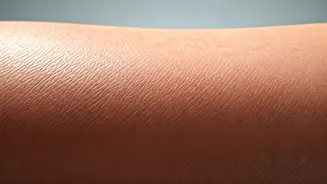Understanding Skin Reactions
Contact dermatitis, a frequent skin issue, occurs when the skin comes into contact with irritating substances or allergens. This interaction triggers inflammation,
presenting symptoms like redness and itching. There are two primary categories: irritant contact dermatitis, induced by direct skin damage, and allergic contact dermatitis, stemming from an immune response. This knowledge is crucial for understanding the condition and developing effective prevention and care strategies.
Dermatitis' Two Faces
Contact dermatitis manifests in two main forms: irritant and allergic. Irritant contact dermatitis, the most common type, accounts for approximately 80% of cases and develops from direct skin damage. This can occur after repeated exposure to harsh chemicals like soaps, detergents, and cleaning agents, stripping the skin of its natural oils. On the other hand, allergic contact dermatitis involves the immune system, mistaking a substance as harmful. It usually appears 1-3 days after exposure to allergens like nickel, fragrances, or certain plants.
Common Causes Identified
Numerous factors can trigger contact dermatitis, often depending on your environment, occupation, and individual sensitivity. Everyday items like shampoos, washing powders, cleaning sprays, and certain skincare products can cause irritation. Occupational exposures, such as those in construction or salons, can elevate risk. Allergens like nickel, fragrances, preservatives, and latex are also common culprits. Those with dry, sensitive skin, eczema, or asthma are particularly susceptible. Harsh weather conditions, cold temperatures and low humidity further weaken the skin, increasing the likelihood of reactions.
Spotting the Symptoms
The symptoms of contact dermatitis vary widely depending on the type of dermatitis, the exposure level, and the duration of skin contact. The reaction usually appears in the area exposed to the substance but can spread in severe cases. Common signs include redness, inflammation, and itching. Dryness, flaking, cracking, and scaling may also occur. More severe instances may involve blisters or oozing. The appearance of the rash also differs depending on skin tone. Irritant contact dermatitis often appears within minutes or hours. Allergic contact dermatitis may take 1-2 days.
Treating and Managing
Effectively managing contact dermatitis involves both treating symptoms and preventing future occurrences. The primary treatment is to identify and avoid the irritant or allergen. Keeping the skin moisturised with fragrance-free, hypoallergenic emollients is crucial for restoring the skin barrier. For severe cases, doctors may prescribe topical corticosteroid creams or ointments. Severe or widespread cases may require oral steroids or a dermatologist consultation. Long-term skin protection involves wearing gloves, keeping nails short, and using a non-perfumed moisturiser regularly to prevent flare-ups.
Prevention Strategies Unveiled
Preventing contact dermatitis involves proactively reducing exposure to potential triggers. Identify and steer clear of known irritants and allergens. Opt for gentle, fragrance-free products for skincare and cleaning. Regular moisturization is key to maintaining a healthy skin barrier. Protective measures like wearing gloves when handling chemicals or cleaning agents are also important. It is wise to test new products on a small area before full use. Take breaks from wet work to give your skin time to recover. Following these steps can substantially lower the chances of developing contact dermatitis.
When to Seek Help
While many cases of contact dermatitis can be managed at home, certain situations require medical attention. Consult a doctor if the rash is severe, painful, or widespread. Seek medical advice if it affects your face, eyes, lips, or genitals. If symptoms persist for more than two weeks despite home treatment or if signs of infection are evident, such as yellow crusting, oozing, or fever, professional medical care is necessary. Timely medical intervention ensures effective management and prevents potential complications, promoting faster skin healing and overall health.













